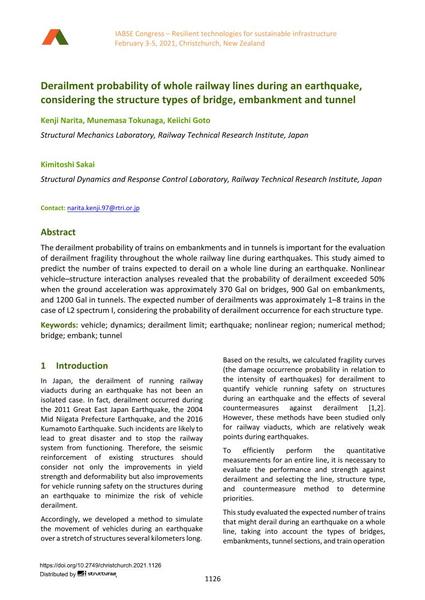Derailment probability of whole railway lines during an earthquake, considering the structure types of bridge, embankment and tunnel

|
|
|||||||||||
Détails bibliographiques
| Auteur(s): |
Kenji Narita
(Structural Mechanics Laboratory, Railway Technical Research Institute, Japan)
Munemasa Tokunaga (Structural Mechanics Laboratory, Railway Technical Research Institute, Japan) Keiichi Goto (Structural Mechanics Laboratory, Railway Technical Research Institute, Japan) Kimitoshi Sakai (Structural Dynamics and Response Control Laboratory, Railway Technical Research Institute, Japan) |
||||
|---|---|---|---|---|---|
| Médium: | papier de conférence | ||||
| Langue(s): | anglais | ||||
| Conférence: | IABSE Congress: Resilient technologies for sustainable infrastructure, Christchurch, New Zealand, 3-5 February 2021 | ||||
| Publié dans: | IABSE Congress Christchurch 2020 | ||||
|
|||||
| Page(s): | 1126-1133 | ||||
| Nombre total de pages (du PDF): | 8 | ||||
| DOI: | 10.2749/christchurch.2021.1126 | ||||
| Abstrait: |
The derailment probability of trains on embankments and in tunnels is important for the evaluation of derailment fragility throughout the whole railway line during earthquakes. This study aimed to predict the number of trains expected to derail on a whole line during an earthquake. Nonlinear vehicle–structure interaction analyses revealed that the probability of derailment exceeded 50% when the ground acceleration was approximately 370 Gal on bridges, 900 Gal on embankments, and 1200 Gal in tunnels. The expected number of derailments was approximately 1–8 trains in the case of L2 spectrum I, considering the probability of derailment occurrence for each structure type. |
||||
| Mots-clé: |
pont tremblement de terre tunnel
|
||||
